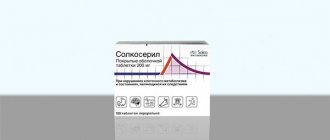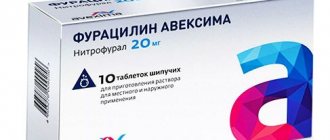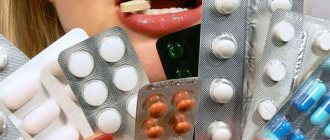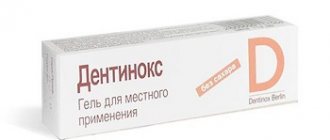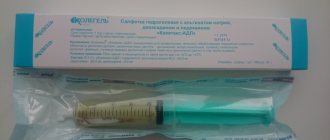Indications and contraindications for Nise therapy
The instructions for the drug indicate that the medication helps with acute attacks of pain and primary dysmenorrhea. Nise is prescribed as a medicine for secondary therapy; the risk of adverse reactions is preliminarily assessed for each patient. The list of diseases for which the medication is effective is presented:
- rheumatoid, psoriatic arthritis;
- articular syndrome that occurs during an exacerbation of gout;
- ankylosing spondylitis;
- osteochondrosis, osteoarthrosis;
- muscle pain;
- pain syndrome that occurs after injuries, surgical interventions, etc.
The drug is contraindicated:
- in case of individual intolerance to nimesulide or other ingredients of their component composition;
- the appearance of nettle fever, allergy symptoms due to previous use of Aspirin or other NSAIDs;
- treatment with other drugs with toxic effects on the liver;
- alcohol or drug addiction;
- bleeding from the gastrointestinal tract, damage to the gastric mucosa when taking NSAIDs;
- problems with the rate of blood clotting;
- dysfunction of the kidneys, heart, liver;
- clinical signs of influenza, ARVI.
The medicine is not used during lactation and in the last trimester of gestation. The drug is contraindicated in patients under twelve years of age and is not used when planning pregnancy due to its effect on fertility.
Use of the drug Nise
In order to prevent the occurrence and to reduce the severity of adverse reactions, the drug should be taken for the shortest possible time and in the minimum effective dose. The drug should be prescribed only after a careful assessment of the risk/benefit ratio. The drug is taken orally after meals and washed down with a sufficient amount of liquid. For adults and children over 12 years old - 1 tablet (100 mg) 2 times a day - morning and evening. The suspension is prescribed to adults and children over 12 years of age at a dose of 100 mg (10 ml) 2 times a day after meals. The maximum daily dose is 200 mg. The maximum duration of treatment is 15 days. For elderly patients, this dosage regimen does not require correction.
Dosages and application options according to the instructions for Nise
A reduction in unwanted reactions of the body during therapy is ensured by the maximum permissible doses and a short course of treatment. Therapeutic procedures do not exceed 15 consecutive days.
The treatment regimen depends on the age of the patient and the current pathological process:
- adults – 0.1 g twice a day after meals;
- elderly - similar to adults, without changes in dosage;
- children 12-18 years old - 100 mg twice a day.
The abstract draws attention to some features:
- mandatory reduction of Nise dosage for patients with impaired renal function;
- possible deterioration of visual acuity when taking NVPS, fluid retention in tissues;
- prohibition on joint use with analogues from the same pharmacological group.
During treatment, regular monitoring of the gastrointestinal tract is required. Due to the high risk of developing drowsiness and inhibition of reactions, during Nise therapy you should avoid driving vehicles, working with complex moving mechanisms, and activities that require precise coordination of movements and speed of reaction.
Nise, tablets 100 mg, 20 pcs.
Manufacturer
Dr. Reddy's, India
Compound
Each tablet contains: Active substance: nimesulide 100 mg. Excipients: calcium hydrogen phosphate 75 mg, microcrystalline cellulose (type 114) 40 mg, corn starch 54 mg, sodium carboxymethyl starch 35 mg, magnesium stearate 3 mg, colloidal silicon dioxide 2 mg, talc 1 mg.
pharmachologic effect
Pharmacotherapeutic group: non-steroidal anti-inflammatory drug (NSAID).
CodeATX:M01AX17. Pharmacological properties Pharmacodynamics
Non-steroidal anti-inflammatory drug (NSAID) from the sulfonanilide class. It is a selective competitive inhibitor of cyclooxygenase-2 (COX-2), inhibits the synthesis of prostaglandins at the site of inflammation. The inhibitory effect on COX-1 is less pronounced (less likely to cause side effects associated with inhibition of prostaglandin synthesis in healthy tissues). It has anti-inflammatory, analgesic and pronounced antipyretic effects.
Pharmacokinetics
Absorption when taken orally is high (food intake reduces the rate of absorption without affecting its degree). Time to reach maximum concentration (Tmax) - 1.5-2.5 hours. Communication with plasma proteins - 95%, with erythrocytes - 2%, with lipoproteins - 1%, with acidic alpha glycoproteins - 1%. Changing the dose does not affect the degree of binding. The maximum concentration value (Cmax) is 3.5-6.5 mg/l. Volume of distribution - 0.19-0.35 l/kg. Penetrates into the tissues of the female genital organs, where after a single dose its concentration is about 40% of the concentration in plasma. Penetrates well into the acidic environment of the inflammation site (40%) and synovial fluid (43%). Easily penetrates histohematic barriers.
Metabolized in the liver by tissue monooxygenases. The main metabolite, 4-hydroxynimesulide (25%), has similar pharmacological activity, but due to a decrease in molecular size, it is able to quickly diffuse through the hydrophobic COX-2 channel to the active binding site of the methyl group. 4-hydroxynimesulide is a water-soluble compound, the elimination of which does not require glutathione and conjugation reactions of phase II metabolism (sulfation, glucuronidation, etc.).
The half-life (T1/2) of nimesulide is 1.56-4.95 hours, 4-hydroxynimesulide is 2.89-4.78 hours. 4-hydroxynimesulide is excreted by the kidneys (65%) and bile (35%), is subject to enterohepatic recycling.
In patients with renal failure (creatinine clearance 1.8-4.8 l/h or 30-80 ml/min), as well as in children and the elderly, the pharmacokinetic profile of nimesulide does not change significantly.
Indications
- rheumatoid arthritis; - articular syndrome during exacerbation of gout; - psoriatic arthritis;
- ankylosing spondylitis;
— osteochondrosis with radicular syndrome;
- osteoarthritis;
— myalgia of rheumatic and non-rheumatic origin;
- inflammation of ligaments, tendons, bursitis, including post-traumatic inflammation of soft tissues;
- pain syndrome of various origins (including in the postoperative period, with injuries, algodismenorrhea, toothache, headache, arthralgia, lumbar ischialgia).
The drug is intended for symptomatic therapy, reducing pain and inflammation at the time of use, and does not affect the progression of the disease.
Contraindications
- Hypersensitivity to the active substance or auxiliary components;
- complete or incomplete combination of bronchial asthma, recurrent polyposis of the nose or paranasal sinuses and intolerance to acetylsalicylic acid and other NSAIDs (including a history);
- erosive and ulcerative changes in the mucous membrane of the stomach and duodenum (duodenum), active gastrointestinal bleeding, cerebrovascular or other bleeding;
- inflammatory bowel diseases (Crohn's disease, ulcerative colitis) in the acute phase;
- hemophilia and other bleeding disorders;
- decompensated heart failure;
- liver failure or any active liver disease;
- anamnestic data on the development of hepatotoxic reactions when using nimesulide preparations;
- concomitant use of potentially hepatotoxic substances;
- alcoholism, drug addiction;
- severe renal failure (creatinine clearance less than 30 ml/min), progressive kidney disease, confirmed hyperkalemia;
- period after coronary artery bypass surgery;
- pregnancy, lactation period;
- children's age up to 12 years.
Carefully
Coronary heart disease, cerebrovascular disease, congestive heart failure, dyslipidemia/hyperlipidemia, diabetes mellitus, peripheral arterial disease, smoking, creatinine clearance less than 60 ml/min. Anamnestic data on the development of ulcerative lesions of the gastrointestinal tract, the presence of Helicobacter pylori infection, old age, long-term use of NSAIDs, frequent alcohol consumption, severe somatic diseases, concomitant therapy with anticoagulants (for example, warfarin), antiplatelet agents (for example, acetylsalicylic acid, clopidogrel), oral glucocorticosteroids ( for example, prednisolone), selective serotonin reuptake inhibitors (for example, citalopram, fluoxetine, paroxetine, sertraline).
Side effects
The frequency of side effects is classified depending on the frequency of occurrence: often - (1-10%), sometimes (0.1-1%), rarely (0.01-0.1%), very rarely (less than 0.01% ), including individual messages.
Allergic reactions: rarely - hypersensitivity reactions; very rarely - anaphylactoid reactions.
From the central nervous system: infrequently - dizziness; rarely - a feeling of fear, nervousness, nightmares; very rarely - headache, drowsiness, encephalopathy (Reis syndrome).
From the skin: infrequently - itching, rash, increased sweating; rarely: erythema, dermatitis; very rare: urticaria, angioedema, facial swelling, erythema multiforme, including Stevens-Johnson syndrome, toxic epidermal necrolysis (Lyell's syndrome).
From the urinary system: infrequently - swelling; rarely - dysuria, hematuria, urinary retention, hyperkalemia; very rarely - renal failure, oliguria, interstitial nephritis.
From the gastrointestinal tract: often - diarrhea, nausea, vomiting; infrequently - constipation, flatulence, gastritis; very rarely - abdominal pain, stomatitis, tarry stools, gastrointestinal bleeding, ulcer and/or perforation of the stomach or duodenum.
From the liver and biliary system: often - increased “liver” transaminases; very rarely - hepatitis, fulminant hepatitis, jaundice, cholestasis.
From the hematopoietic organs: rarely - anemia, eosinophilia; very rarely - thrombocytopenia, pancytopenia, purpura, prolonged bleeding time.
From the respiratory system: infrequently - shortness of breath; very rarely - exacerbation of bronchial asthma, bronchospasm.
From the senses: rarely - blurred vision.
From the cardiovascular system: infrequently - arterial hypertension; rarely - tachycardia, hemorrhages, hot flashes. Other: rarely - general weakness; very rarely - hypothermia.
Interaction
The effect of medications that reduce blood clotting is enhanced when used simultaneously with nimesulide.
Nimesulide may reduce the effect of furosemide. Nimesulide may increase the possibility of side effects while taking methotrexate.
Plasma lithium levels increase when lithium and nimesulide are taken simultaneously.
Nimesulide may enhance the effect of cyclosporine on the kidneys.
Use with glucocorticosteroids and serotonin reuptake inhibitors increases the risk of gastrointestinal bleeding.
How to take, course of administration and dosage
The minimum effective dose should be used for the shortest possible short course. The tablets are taken with enough water, preferably after meals. Adults and children over 12 years of age, take 1 tablet orally 2 times a day. If you have diseases of the gastrointestinal tract, it is advisable to take the drug at the end of a meal or after a meal. The maximum daily dose for adults is 200 mg. Patients with chronic renal failure require a reduction in the daily dose to 100 mg.
Overdose
Symptoms: apathy, drowsiness, nausea, vomiting. Gastrointestinal bleeding, increased blood pressure, acute renal failure, and respiratory depression may occur.
Treatment: The patient requires symptomatic treatment and supportive care. There is no specific antidote. If an overdose occurs within the last 4 hours, it is necessary to induce vomiting, take activated carbon (60-100 g per adult), and osmotic laxatives. Forced diuresis and hemodialysis are ineffective due to the high binding of the drug to proteins.
Special instructions
Since Nise® is partially excreted by the kidneys, its dose should be reduced in patients with impaired renal function, depending on creatinine clearance. Given reports of visual disturbances in patients taking other NSAIDs, treatment should be stopped immediately if any visual disturbance occurs and the patient should be examined by an ophthalmologist.
The drug can cause fluid retention in tissues, so patients with high blood pressure and cardiac problems should use Nise® with extreme caution.
Patients should undergo regular medical monitoring if they, along with nimesulide, take medications that are characterized by an effect on the gastrointestinal tract.
If signs of liver damage appear (itching, yellowing of the skin, nausea, vomiting, abdominal pain, dark urine, increased levels of liver transaminases), you should stop taking the drug and consult your doctor. The drug should not be used simultaneously with other NSAIDs.
The drug can change the properties of platelets, but does not replace the preventive effect of acetylsalicylic acid in cardiovascular diseases. The use of the drug may adversely affect female fertility and is not recommended for women planning pregnancy.
After 2 weeks of using the drug, monitoring of biochemical indicators of liver function is necessary.
This dosage form is contraindicated for children under 12 years of age, but if it is necessary to use nimesulide in children over 7 years of age, 50 mg dispersible tablets and suspension can be used in strict accordance with the instructions for medical use attached to them.
Since the drug can cause drowsiness, dizziness and blurred vision, care must be taken when driving vehicles and engaging in other potentially hazardous activities that require increased concentration and speed of psychomotor reactions.
Storage conditions
List B. In a dry place, protected from light, at a temperature not exceeding 25°C. Keep out of the reach of children!
Best before date
3 years
Active substance
Nimesulide
Conditions for dispensing from pharmacies
On prescription
Dosage form
pills
Purpose
For adults as prescribed by a doctor, Children over 12 years old, Children as prescribed by a doctor
Indications
Migraine, Radiculitis, Bursitis, Arthritis, Gout, Dislocations and sprains, Tendon inflammation, Myositis, Osteochondrosis, Rheumatoid arthritis, Sciatica, Arthrosis, Lumbago
Barcode and weight
Barcode: 8901148052031, 8901148005836, 8901148236608, 0118901148005 Weight: 0.013 kg
Adverse reactions and overdose
Clinical studies have shown that use of the drug in high dosages may increase the risk of developing diseases caused by arterial thrombosis. During therapeutic manipulations, patients experienced swelling, increased blood pressure, and heart failure.
Common adverse reactions to Nise include:
- bleeding from the gastrointestinal tract;
- peptic ulcers, gastric perforation;
- attacks of vomiting with nausea;
- active gas formation, diarrhea;
- dyspeptic disorders;
- pain in the abdominal area;
- tarry stools, ulcerative stomatitis.
The development of gastritis was observed less frequently in patients.
Accidentally exceeding the prescribed amount of Nise can cause drowsiness, apathy, discomfort in the epigastric region, vomiting with nausea. These phenomena are reversible and can be treated with symptomatic treatment.
Sometimes there is an increase in blood pressure, respiratory depression, bleeding from the gastrointestinal tract, and coma. An overdose of NSAIDs threatens the development of allergic reactions, including angioedema and anaphylaxis.
The pathological condition is treated with maintenance therapy using activated carbon (1 tablet per 10 kg of body weight) or an osmotic laxative. At the same time, renal and hepatic functionality is monitored.
Nise drug overdose, symptoms and treatment
symptoms: lethargy, drowsiness, nausea, vomiting, epigastric pain, gastrointestinal bleeding, hypertension (arterial hypertension), acute renal failure, respiratory depression, anaphylactoid reactions and coma may also occur. Treatment. There is no specific antidote. In case of overdose, symptomatic therapy should be carried out. During the first 4 hours, patients need to rinse their stomach and take activated charcoal. Hemodialysis is not effective. Careful monitoring of liver and kidney function is necessary.
